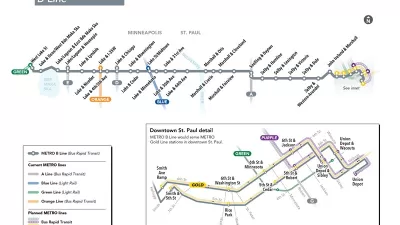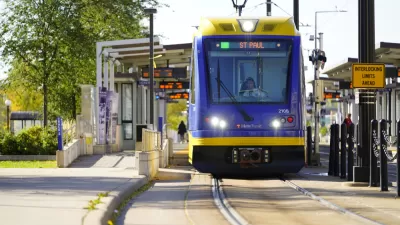Recognizing that providing transit passes to students costs about the same as operating a system of buses in-house, some schools are giving students access to public transit.
"This year, St. Paul Public Schools (SPPS) launched a pilot program to study how feasible it may be to send their high school students to and from school via city bus," reports Kritoffer Tigue. "And if the program proves successful, St. Paul may soon be joining Minneapolis in doing away with most yellow buses for their public high schools."
The program, the result of a partnership between SPPS and Metro Transit, allows students "to ride city buses to and from school, as well as for personal use over the weekend." School officials have proposed several potential benefits of the program: first is more flexibility for students participating in a number of after-school activities. Also, "officials say the program will also help break down barriers for students of color and low income families, who often can’t participate in certain activities or obtain work because of a lack of good transportation options."
SPPS is far from the first school district to choose public transit over yellow buses. According to Tigue, "Minneapolis Public Schools began using city buses for student transportation for five of their high schools in 2012, but upped it to seven the following year. This year, around 6,500 MPS high school students are using their Student Pass program, according to Metro Transit, and another 40 schools throughout the metro region are buying into the program by the end of the year."
Although the benefits to the student population are well documented in the article, the potential benefits to short- and long-term ridership, revenues, or route planning are potential avenues of study stemming from programs like those located in Twin Cities.
FULL STORY: St. Paul becomes latest district to study doing away with school buses

Planetizen Federal Action Tracker
A weekly monitor of how Trump’s orders and actions are impacting planners and planning in America.

Maui's Vacation Rental Debate Turns Ugly
Verbal attacks, misinformation campaigns and fistfights plague a high-stakes debate to convert thousands of vacation rentals into long-term housing.

San Francisco Suspends Traffic Calming Amidst Record Deaths
Citing “a challenging fiscal landscape,” the city will cease the program on the heels of 42 traffic deaths, including 24 pedestrians.

Defunct Pittsburgh Power Plant to Become Residential Tower
A decommissioned steam heat plant will be redeveloped into almost 100 affordable housing units.

Trump Prompts Restructuring of Transportation Research Board in “Unprecedented Overreach”
The TRB has eliminated more than half of its committees including those focused on climate, equity, and cities.

Amtrak Rolls Out New Orleans to Alabama “Mardi Gras” Train
The new service will operate morning and evening departures between Mobile and New Orleans.
Urban Design for Planners 1: Software Tools
This six-course series explores essential urban design concepts using open source software and equips planners with the tools they need to participate fully in the urban design process.
Planning for Universal Design
Learn the tools for implementing Universal Design in planning regulations.
Heyer Gruel & Associates PA
JM Goldson LLC
Custer County Colorado
City of Camden Redevelopment Agency
City of Astoria
Transportation Research & Education Center (TREC) at Portland State University
Jefferson Parish Government
Camden Redevelopment Agency
City of Claremont





























